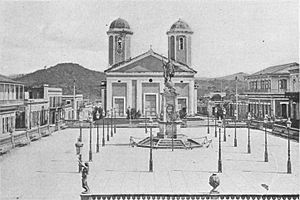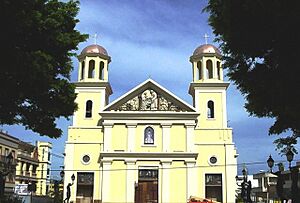History of Mayagüez facts for kids
The city of Mayagüez, located in Western Puerto Rico, was founded by Spanish colonists in 1760. However, the area had been settled by the native Taínos people for many years before that. Mayagüez gained the right to govern itself in 1763 and became a villa (a special type of town) in 1836. A big fire in 1841 caused a lot of damage, leading to extensive rebuilding. The town became known for its unique local identity and was home to important thinkers like Eugenio María de Hostos and Ramón Emeterio Betances, who supported independence. Mayagüez officially became a city in 1877.
During the Spanish–American War in 1898, U.S. troops entered Mayagüez peacefully on August 11. The college that later became the University of Puerto Rico at Mayagüez opened in 1911. The city suffered severe damage again in the 1918 San Fermín earthquake. In the later 20th century, Mayagüez developed a large export trade with the U.S., mainly focusing on tuna processing and textiles.
Contents
Founding the City of Mayagüez
The history of Mayagüez began when a group led by Faustino Martínez de Matos, Juan de Silva, and Juan de Aponte asked to found a city on July 19, 1760. They chose a hill about one kilometer from Mayagüez Bay and the mouth of the Yagüez River. The city was officially founded on September 18, 1760.
The name "Mayagüez" comes from "Maygüez," the native Taíno name for the river, which means "clear water." "Mayagüez" is a different version of this name, meaning "Land of Clear Waters," and it became the city's nickname. The Taínos had lived in this area for hundreds of years before the town was founded, at a nearby settlement called Yagüeca.
In 1763, the Spanish Crown allowed the founders to govern themselves, officially separating the town from the larger area of San Germán. The settlement was first named Nuestra Señora de la Candelaria de Mayagüez (Our Lady of the Candelaria of Mayagüez). Most of the early settlers, including the founders, came from the Canary Islands, where the Virgin of Candelaria is a patron saint.
In 1777, two American ships, the Endowok and the Henry, hid in Mayagüez Bay to escape a British ship, HMS Glasgow. The local government lent two Spanish flags to the American ships to make them look Spanish. After the British captain protested without success, he decided not to attack and left the area.
Mayagüez Becomes a Villa and the Great Fire of 1841
On May 7, 1836, the settlement was given the royal status of villa, and Rafael Mangual became its first mayor. At that time, farming was the main economic activity in the villa. The famous patriot, educator, and philosopher Eugenio María de Hostos was born in Mayagüez in 1839.
On January 30, 1841, a fire almost completely destroyed the villa. It burned 300 out of 500 homes. The town was rebuilt with some of its main roads made wider to help prevent future fires from spreading quickly. The Spanish military governor of Puerto Rico, Gen. Santiago de Méndez Vigo, personally raised money to rebuild the entire city. One of Mayagüez's main roads was later named in his honor.
The local fire department was started in 1843. It helped control major fires in 1852 and 1866 and also assisted with hurricane rescue and relief efforts in 1852. The villa's first census was taken in 1844.
Mayagüez later became an important cultural and political center for western Puerto Rico. Because it was somewhat isolated from the rest of the island (located in a coastal valley surrounded by mountains), Mayagüez developed a unique local culture and a strong sense of regional pride. This strong, independent culture helped produce not only liberal thinkers like Eugenio María de Hostos but also radical ones like Dr. Ramón Emeterio Betances. Dr. Betances is known as the father of the Puerto Rican independence movement and was the first medical director of Mayagüez's Municipal Hospital. Another important figure was Segundo Ruiz Belvis, a leader in the Puerto Rican Abolitionism movement. The Grito de Lares, Puerto Rico's first major pro-independence revolt, was planned near Mayagüez. Dr. Betances had also helped save the town from a cholera epidemic years earlier. Today, the local medical center and a main road are named after Dr. Betances.
In 1870, a telegraph line to the capital city of San Juan was opened. Postal service between the two cities and other places had existed since 1858.
Mayagüez Becomes a City
On July 10, 1877, the villa officially received its city charter from the Royal Crown of Spain.
The Escuela Libre de Música or Free Music School was founded in 1894 and led by Fernando Callejo. In 1896, a statue honoring Cristopher Columbus was placed in the main plaza. That same year, the villa officially received its current formal title: "Excelente Ciudad de Mayagüez" (Excellent City of Mayagüez). The local produce market, the Plaza del Mercado, which used to be an open-air market, was moved into a new building built in the early 1890s. This building was a prefabricated structure designed by Gustave Eiffel's construction company.
Mayagüez in the Late 19th and 20th Centuries

On August 11, 1898, during the Spanish–American War, U.S. troops entered Mayagüez. Spanish troops surrounded the city, but no battle took place, and the American troops were welcomed. A young local boy was given the task of raising the American flag at the City Hall. He accidentally raised it upside down, which is a symbol of distress, but he didn't know this. Some American troops later settled in Mayagüez.
In 1911, the College of Agriculture and Mechanic Arts was founded in Mayagüez. Today, it is known as the University of Puerto Rico at Mayagüez (UPRM), a leading science and engineering institution in the Caribbean.
The city of Mayagüez was almost destroyed again on October 11, 1918, by an earthquake and a tsunami. Most of the town had to be rebuilt, including the U.S. Customs House and the Mayagüez City Hall. On June 20, 1919, a fire nearly destroyed the Teatro Yagüez, the town's main theater, causing many deaths. The theater was later rebuilt and remodeled twice and is now Mayagüez's municipal theater.
The city's main Roman Catholic church, Our Lady of the Candelaria, was rebuilt in 1922. The original plan was to restore the building to its former beauty, as the 1918 earthquake had damaged the ceiling and lightning had struck one of its bell towers. However, due to a lack of money and the extent of the damage, the rebuilding had to be scaled down.
Pope Paul VI approved the founding of the Diocese of Mayagüez on April 1, 1976. This led to the church being rededicated as a cathedral soon after. A few years later, the first bishop of the city, Mons. Ulises Casiano Vargas, led the effort to remodel the cathedral following the original plan. The remodeled cathedral reopened on January 1, 2004.
Between 1962 and 1998, Mayagüez was a major center for canning and processing tuna. At one point, 80% of all tuna products eaten in the United States were packed in Mayagüez. The largest employer, StarKist, had 11,000 employees working in the local plant during its busiest times. Mayagüez was also a big center for the textile industry. Until recently, almost a quarter of all drill uniforms used by the United States Army were sewn in the city.
During a celebration in 1975, an incident occurred in the Plaza del Municipio, leading to injuries and the loss of lives.
On May 12, 1975, a unit of the Cambodian Khmer Rouge took control of a container ship called the SS Mayagüez in the Gulf of Siam. The rescue attempt for the ship's crew on May 15 became known as the Mayagüez Incident. The ship was owned by Sea-Land Service, which operated container service to Puerto Rico, explaining why the city's name was part of this major international event.
See also
- Timeline of Mayagüez, Puerto Rico
- National Register of Historic Places listings in Mayagüez, Puerto Rico



